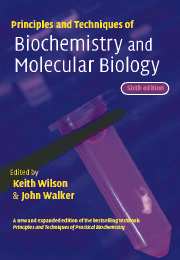Book contents
- Frontmatter
- Contents
- Preface to the sixth edition
- List of contributors
- List of abbreviations
- 1 Basic principles
- 2 Cell culture techniques
- 3 Centrifugation
- 4 Microscopy
- 5 Molecular biology, bioinformatics and basic techniques
- 6 Recombinant DNA and genetic analysis
- 7 Immunochemical techniques
- 8 Protein structure, purification, characterisation and function analysis
- 9 Mass spectrometric techniques
- 10 Electrophoretic techniques
- 11 Chromatographic techniques
- 12 Spectroscopic techniques: I Atomic and molecular electronic spectroscopy
- 13 Spectroscopic techniques: II Vibrational spectroscopy and electron and nuclear spin orientation in magnetic fields
- 14 Radioisotope techniques
- 15 Enzymes
- 16 Cell membrane receptors
- Index
- Plate sections
14 - Radioisotope techniques
Published online by Cambridge University Press: 05 June 2012
- Frontmatter
- Contents
- Preface to the sixth edition
- List of contributors
- List of abbreviations
- 1 Basic principles
- 2 Cell culture techniques
- 3 Centrifugation
- 4 Microscopy
- 5 Molecular biology, bioinformatics and basic techniques
- 6 Recombinant DNA and genetic analysis
- 7 Immunochemical techniques
- 8 Protein structure, purification, characterisation and function analysis
- 9 Mass spectrometric techniques
- 10 Electrophoretic techniques
- 11 Chromatographic techniques
- 12 Spectroscopic techniques: I Atomic and molecular electronic spectroscopy
- 13 Spectroscopic techniques: II Vibrational spectroscopy and electron and nuclear spin orientation in magnetic fields
- 14 Radioisotope techniques
- 15 Enzymes
- 16 Cell membrane receptors
- Index
- Plate sections
Summary
THE NATURE OF RADIOACTIVITY
Atomic structure
An atom is composed of a positively charged nucleus that is surrounded by a cloud of negatively charged electrons. The mass of an atom is concentrated in the nucleus, even though it accounts for only a small fraction of the total size of the atom. Atomic nuclei are composed of two major particles, protons and neutrons. Protons are positively charged particles with a mass approximately 1850 times greater than that of an orbital electron. The number of orbital electrons in an atom must be equal to the number of protons present in the nucleus, since the atom as a whole is electrically neutral. This number is known as the atomic number (Z). Neutrons are uncharged particles with a mass approximately equal to that of a proton. The sum of protons and neutrons in a given nucleus is the mass number (A). Thus
A=Z+N
where N is the number of neutrons present.
Since the number of neutrons in a nucleus is not related to the atomic number, it does not affect the chemical properties of the atom. Atoms of a given element may not necessarily contain the same number of neutrons. Atoms of a given element with different mass numbers (i.e. different numbers of neutrons) are called isotopes. Symbolically, a specific nuclear species is represented by a subscript number for the atomic number, and a superscript number for the mass number, followed by the symbol of the element.
- Type
- Chapter
- Information
- Principles and Techniques of Biochemistry and Molecular Biology , pp. 621 - 664Publisher: Cambridge University PressPrint publication year: 2005



